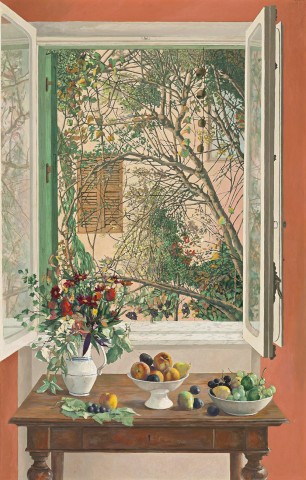STILL LIFE AGAINST A WINDOW, 1981
JUSTIN O'BRIEN
oil on canvas
121.0 x 78.0 cm
signed upper right: O’BRIEN
Macquarie Galleries, Sydney
Artbank, Sydney
Justin O'Brien: recent paintings from Rome, Macquarie Galleries, Sydney, 28 September – 16 October 1982, cat. 1
Art and Australia, Sydney, vol. 19, no. 4, winter 1982, p. 380 (illus., as ‘Still Life Against Window’)
Grishin, S., ‘An Australian Painter in Rome: Justin O’Brien’, Art and Australia, Sydney, vol. 21, no. 4, Winter 1984, pp. 495 (illus., as ‘Still Life Against Window’), 496
Resplendent in its varied colour, texture and detail, Still Life against a Window, 1981 captures amongst its fibres and layers the heavy stillness of a late Italian summer. Ambitious in both scale and level of detail, this painting is undoubtedly a work that stands apart from the mass of O’Brien’s late still lives. Having recently returned to Rome after months of travelling through Turkey, the summer months of 1981 would mark a time of renewed inspiration and invigorated artistic practice for the Australian expatriate painter.1
While O’Brien rose to critical acclaim with narrative paintings depicting biblical episodes, his later years were characterised by a more pronounced naturalism and subject matter that was more prosaic and bucolic. Landscapes and still life subjects remained touchstones throughout the artist’s career – translating the divine power that he recognised in the everyday, particularly whilst living in Greece and Italy. Many of O’Brien’s compositions from the late 1970s onwards featured opened windows and doorways, playing with the Renaissance idea of the canvas as a window into an alternate reality. Explaining his rationale in a conversation with Desmond O’Grady in 1986 O’Brien said: ’I am interested in the way representations of looking out from a room enable you to convey a feeling of three-dimensional space … I’m absorbed in painting domestic life’. 2
What distinguishes this Still Life against a Window is its pictorial richness and the way it appeals to all of our senses. The tone and texture of the scene are carefully observed and faithfully transcribed as O’Brien conveys the coolness of the marble window sill, the flickering reflections on window panes, soft and velvety fruits and feathery blooms. In comparison to its closest related work, Window 2, 1978, which features the same window, this painting is warmer and more complex, counterbalanced compositionally through the placement of a table in the foreground, laden with fresh earthly offerings.
Considering the religious nature of much of O’Brien’s oeuvre, one realises that even his more prosaic compositions are endowed with a spiritual subtext. Concealing religious architectural forms within this domestic composition, from the marble sill and wooden table as altar, the shutters and window panes as the outermost panels of an altarpiece, O’Brien transforms this corner of his Roman apartment a humble place of worship. This is further emphasised through the placement of a simple string of Skyrian bells hanging from the window frame.
Sasha Grishin, Emeritus professor of Art History at the Australian National University, travelled to Rome to interview Justin O’Brien a few years after this painting was executed. In the article subsequently published in Art and Australia, Grishin wrote:
‘In the early 1980s, he painted a series of still life compositions that must rate amongst his best work. These include his Still Life Against The Window, 1981 [sic.]. Light now permeates every surface as the whole starts to glow with colour. The symbolism, which in some of his earlier work appeared as somewhat heavy handed, has now vanished and is replaced by inner radiance of colour expressed in terms of vibrating, glowing fields’.3
1. See Pearce, B., and Wilson, N., Justin O’Brien. The Sacred Music of Colour, Art Gallery of New South Wales, Sydney, 2011, p. 168
2. The artist in conversation with Desmond O’Grady, Rome, 1986, quoted in ibid., p. 169
3. Grishin, S., ‘An Australian Artist in Rome’, Art and Australia, vol. 21, no. 4, winter 1984, p. 496. The work in question illustrated on p. 495, as ‘Still Life Against Window’
LUCIE REEVES-SMITH
